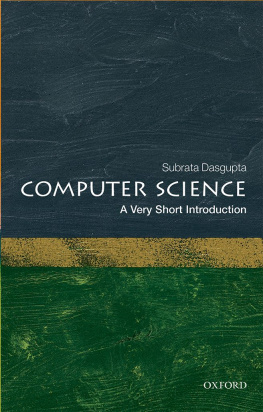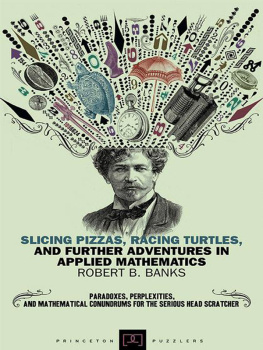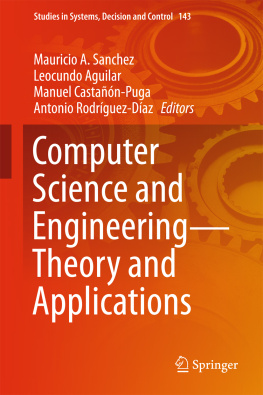Konheim - Hashing in computer science: fifty years of slicing and dicing
Here you can read online Konheim - Hashing in computer science: fifty years of slicing and dicing full text of the book (entire story) in english for free. Download pdf and epub, get meaning, cover and reviews about this ebook. City: Hoboken, N.J, year: 2010, publisher: John Wiley & Sons, Inc., genre: Children. Description of the work, (preface) as well as reviews are available. Best literature library LitArk.com created for fans of good reading and offers a wide selection of genres:
Romance novel
Science fiction
Adventure
Detective
Science
History
Home and family
Prose
Art
Politics
Computer
Non-fiction
Religion
Business
Children
Humor
Choose a favorite category and find really read worthwhile books. Enjoy immersion in the world of imagination, feel the emotions of the characters or learn something new for yourself, make an fascinating discovery.
Hashing in computer science: fifty years of slicing and dicing: summary, description and annotation
We offer to read an annotation, description, summary or preface (depends on what the author of the book "Hashing in computer science: fifty years of slicing and dicing" wrote himself). If you haven't found the necessary information about the book — write in the comments, we will try to find it.
Konheim: author's other books
Who wrote Hashing in computer science: fifty years of slicing and dicing? Find out the surname, the name of the author of the book and a list of all author's works by series.
Hashing in computer science: fifty years of slicing and dicing — read online for free the complete book (whole text) full work
Below is the text of the book, divided by pages. System saving the place of the last page read, allows you to conveniently read the book "Hashing in computer science: fifty years of slicing and dicing" online for free, without having to search again every time where you left off. Put a bookmark, and you can go to the page where you finished reading at any time.
Font size:
Interval:
Bookmark:

Copyright 2010 by John Wiley & Sons, Inc. All rights reserved
Published by John Wiley & Sons, Inc., Hoboken, New Jersey
Published simultaneously in Canada
No part of this publication may be reproduced, stored in a retrieval system, or transmitted in any form or by any means, electronic, mechanical, photocopying, recording, scanning, or otherwise, except as permitted under Section 107 or 108 of the 1976 United States Copyright Act, without either the prior written permission of the Publisher, or authorization through payment of the appropriate per-copy fee to the Copyright Clearance Center, Inc., 222 Rosewood Drive, Danvers, MA 01923, (978) 750-8400, fax (978) 750-4470, or on the web at www.copyright.com. Requests to the Publisher for permission should be addressed to the Permissions Department, John Wiley & Sons, Inc., 111 River Street, Hoboken, NJ 07030, (201) 748-6011, fax (201) 748-6008, or online at http://www.wiley.com/go/permission.
Limit of Liability/Disclaimer of Warranty: While the publisher and author have used their best efforts in preparing this book, they make no representations or warranties with respect to the accuracy or completeness of the contents of this book and specifically disclaim any implied warranties of merchantability or fitness for a particular purpose. No warranty may be created or extended by sales representatives or written sales materials. The advice and strategies contained herein may not be suitable for your situation. You should consult with a professional where appropriate. Neither the publisher nor author shall be liable for any loss of profit or any other commercial damages, including but not limited to special, incidental, consequential, or other damages.
For general information on our other products and services or for technical support, please contact our Customer Care Department within the United States at (800) 762-2974, outside the United States at (317) 572-3993 or fax (317) 572-4002.
Wiley also publishes its books in a variety of electronic formats. Some content that appears in print may not be available in electronic formats. For more information about Wiley products, visit our web site at www.wiley.com.
Library of Congress Cataloging-in-Publication Data
Konheim, Alan G., 1934
Hashing in computer science : fifty years of slicing and dicing / Alan G. Konheim.
p. cm.
ISBN 978-0-470-34473-6
ISBN 978-1-118-03183-4(ebk)
1. Hashing (Computer science) 2. Cryptography. 3. Data encryption (Computer science) 4. Computer security. I. Title.
QA76.9.H36K65 2010
005.82dc22
2009052123
To my grandchildren
Madelyn, David, Joshua, and Karlina
PREFACE
0.1 WHAT IS HASHING
The Merriam-Webster Dictionary (1974) provides several definitions for hash :
- noun: an American food made by combining and compressing chopped-up leftoversmeat, eggs, and potatoes.
- verb: to chop into small pieces; make into hash; mince.
- noun: colloquial for hashish (or hashish ), the resin collected from the flowers of the cannabis plant. The primary active substance is THC (tetrahydrocannabinol), although several other cannabinoids are known to occur. Hash is usually smoked in pipes, water pipes, joints, and hookahs, sometimes mixed with cannabis flowers or tobacco. It can also be eaten.
A search for hashing on Google yields 1,720,000 hits; of course, it doesnt come close to the 670,000,000 hits for sex or even the 129,000,000 hits for money , but then
Although hashing may be exhilarating and even intoxicating, this book deals with its applications in computer science relating to the processing of information that is both old (1953+) and new (1990+).
0.2 MY HASHING ROOTS
Nat Rochester was the software project manager for the IBM 701 machine; together with Gene M. Amdahl, Elaine M. McGraw (ne Boehme), and Arthur L. Samuel, they considered a key-value-to-address machine for the 701 assembler. Several sources agree that Amdahl invented linear open addressing, a form of hashing ( aka scatter storage), when confronted with the problem of collisions.
I was a Research Staff member in the Department of Mathematical Sciences at the IBM Thomas J. Watson Research Center in Yorktown Heights (New York) from 1960 to 1982. Sometime in 1964, I was asked by my manager to meet with Wes Peterson (19242009) to learn about his work on hashing. Wes was a former employee of and now consultant to IBM; in 1964, he was a faculty member at one of the University of Florida campuses. Wes used simulation to evaluate the performance of linear probing , an algorithm developed during the design of the IBM 701 machine. As a result of our conversation, I started to work with Benjamin Weiss, then a post-doc at IBM, now a Professor Emeritus at the Hebrew University in Jerusalem, to develop a combinatorial analysis of hashing with linear probing.
In a footnote on page 529 of The Art of Computer Programming: Volume 3/Sorting and Searching (Addison-Wesley Publishing Company, 1973), Professor Donald Knuth wrote that his running-time analysis of Algorithm L was the first non-trivial algorithm I had ever analyzed satisfactorily. He also noted that more than ten years would go by before the derivation got into print! Algorithm L is central to the performance of linear probing , which is essentially the hashing algorithm proposed by Gene Amdahl. Ben Weiss and I found the formula Nj ( j + 1)( j 1) (Theorem 13.2 is Knuths Algorithm L), which counts the number of hash sequences inserting j keys in a hash table of size j + 1 leaving the last hash table address unoccupied. First, we computed by hand the values Nj for j = 2, 3, 4 until we recognized the form of the algebraic expression ( j + 1)( j 1), a technique that I have suggested to students in other contexts.
I contacted Wes again in 1997, where he was and remains today a Professor of Computer Science at the University of Hawaii. I inquired about a sabbatical leave there in 1999. My wife and I visited Wes and his wife Hiromi at their home in December 1997 while celebrating our 40th anniversary. Wes had just been awarded the Japan Prize, and both Petersons were both contemplating sabbatical leaves in Japan starting in January 1999. Timing is everything! I was hired by Wes and Hiromi to watch over their dog Koko; I was certainly the highest paid dog sitter in the Hawaiian Islands. Koko was a constant source of innocent merriment during my 5-month sabbatical; he curiously developed a significant taste for Hebrew National salami, and our acquiescing to his new found tastes was criticized by both Wes and Kokos veterinarian. However, before leaving for Japan, Wes warned my wife that Koko might die before their return. The miraculous and curative powers of Hebrew National salamiWe Answer To a Higher Authority added 2 years to Kokos life. We saw Wes again when we returned to Hawaii to celebrate our 50th anniversary in July 2007.
0.3 THE ORIGINAL APPLICATION OF HASHING (DATA STORAGE)
When data are stored and manipulated in a computer system, a mechanism must be provided to access the data easily. We view information in storage as composed of records of variable sizes located in the system storage media in a variety of regions, especially in dynamic file systems. A unique key is associated with and stored in each record. This key could be a name or a suitable number, but in general, any string can serve as a unique identifier. The key is used by the programs processing the data to locateto SEARCH for the address ofthe desired record. When a telephone directory is used to determine a telephone number, SEARCH is somewhat easier than the general instance of file management because the records composed of the triple (Name Address TelephoneNumber) are stored sorted on the Name field .
Font size:
Interval:
Bookmark:
Similar books «Hashing in computer science: fifty years of slicing and dicing»
Look at similar books to Hashing in computer science: fifty years of slicing and dicing. We have selected literature similar in name and meaning in the hope of providing readers with more options to find new, interesting, not yet read works.
Discussion, reviews of the book Hashing in computer science: fifty years of slicing and dicing and just readers' own opinions. Leave your comments, write what you think about the work, its meaning or the main characters. Specify what exactly you liked and what you didn't like, and why you think so.











